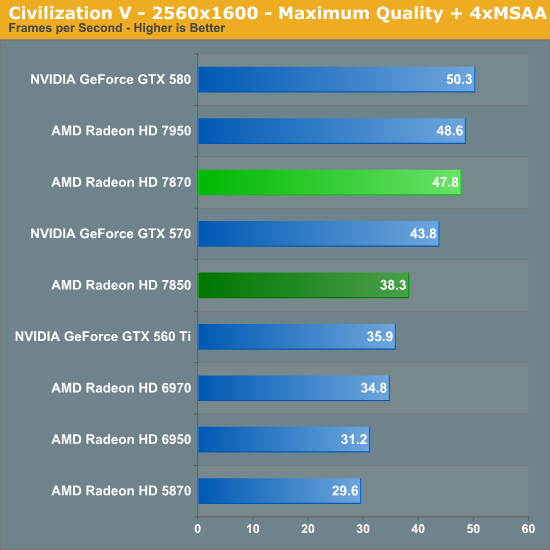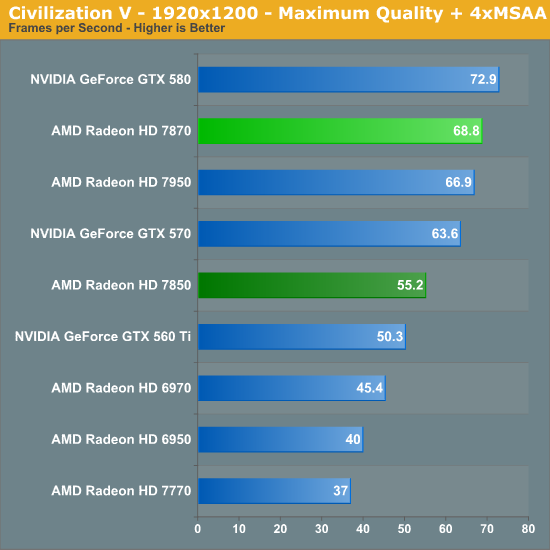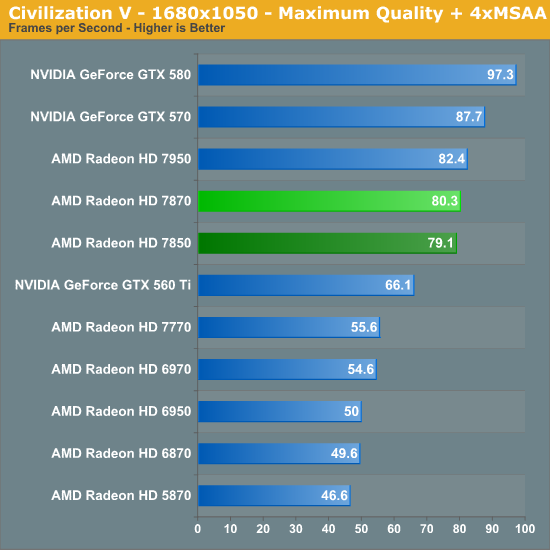AMD Radeon HD 7870 GHz Edition & Radeon HD 7850 Review: Rounding Out Southern Islands
by Ryan Smith on March 5, 2012 12:01 AM ESTCivilization V
Our final game, Civilization 5, gives us an interesting look at things that other RTSes cannot match, with a much weaker focus on shading in the game world, and a much greater focus on creating the geometry needed to bring such a world to life. In doing so it uses a slew of DirectX 11 technologies, including tessellation for said geometry, driver command lists for reducing CPU overhead, and compute shaders for on-the-fly texture decompression.



CivV has something interesting going on at 1920; can you spot it? For the first and only time, the 7870 ends up leading over the 7950, if only by 2%. Even though AMD’s performance improvements in CivV seem to largely be driven by compute shader performance improvements, there’s apparently still something going on with the frontend or the ROPs that makes the 7870’s higher core clockspeed matter.
In any case this is another game where the 7800 comes out looking quite good. Relative to the 6900 series there is no competition: the 7800 series is 40-50% faster. The lead against NVIDIA’s cards isn’t nearly as large, but it’s still 8% for the 7870 versus the GTX 570, and 9% for the 7850 versus the GTX 560 Ti.










173 Comments
View All Comments
arjuna1 - Monday, March 5, 2012 - link
Metro 2033 (the highest settings bench)Radeon 7950 33fps
Radeon 6970 27.5fps
Radeon 6870 32fps (the second highest bench)
Weee!!! $400+ for 5.5fps more.
Not sure about you, but to me, spending that kind of cash for an imperceptible increase in performance is having no sense of money's worth.
This generation of cards can safely be skipped until the 8xxx/7xx series from both AMD and NVIDIA.
Death666Angel - Tuesday, March 6, 2012 - link
Picking up one specific benchmark to underline your point. Great reasoning skills, you should join a debate team! Also, that 5.5fps is still 20%, with the good track record of overclockability, it can reach as much as 40%. But you stick to your point.arjuna1 - Tuesday, March 6, 2012 - link
What? were you expecting me to post a powerpoint presentation for just for you??The numbers are there, look at them if you want, but hey, be stuck in your point, only a frustrated basement geek can think in way to justify spending $400 +/- for less than 50% increase in performance.
Be careful of not falling of that horse, seems pretty high.
sseemaku - Tuesday, March 6, 2012 - link
Please check the avg frame rate improvements, not some specific results. But everyone agrees that 7xxx cards are a bit overpriced and that's because they don't have competition right now. If you worry about power consumption, buy these cards now. Or more interested in price/performance, wait till Kepler is released.arjuna1 - Tuesday, March 6, 2012 - link
I can agree with that, after Kepler is release prices will go down and maybe then the 7xxx series will increase in the perceived value.CeriseCogburn - Thursday, March 8, 2012 - link
If there's no competition then they aren't overpriced because they cannot be touched by anything, hence making their price absolutely correct !!!I call that "reality".
If Kepler blows their doors off, their price will fall. That's reality too.
It's time for all the amd is cheaper crud to go the way of the dinosaur.
Recently a 460 was an unbeatable value. Then a 560ti was as unbeatable value. Currently a 6870 is an unbeatable value.
These things happen, and a deal is not the general aspect of the video card prices, which generally speaking wind up right where they should be.
The deal is the exception to the usual rule across the board, and "the deal" as in "big price drop" is usually just one card here or there for a short period of time.
CeriseCogburn - Thursday, March 8, 2012 - link
Radeon cards have been coming out at $700 and $600 and $500+ for a long time man - even with competition.I don't know what planet you people come from when the constant repetition of "it sounds good" becomes an absolute meme and ongoing restated theme but in no way reflects even a tiny kernel of truth as far as reality goes.
CeriseCogburn - Friday, March 9, 2012 - link
Yes dagamer34, Ryan praises amd for drying up their 6000 series channel with such precision. Then we get this praise - the perfect price structure by AMD, and "it's conservative pricing" according to the author even though it's $40 and $30 higher than it's Nvidia counterpart..." With AMD targeting the ~$320 570 and ~$210 560 Ti and given their conservative pricing on the rest of Southern Islands, it should come as no surprise that the 7800 series is priced equally conservatively. The 7870 will have an MSRP of $350, while the 7850 will have an MSRP of $250. With the 7800 series completing the launch of Southern Islands, this gives AMD a consistent price structure for the entire family: $550, $450, $350, $250, $159, and $109."
---
I see. So more expensive is conservative, and the 6 AMD price figures are perfect and consistent...
I am so sick of it...
Falkenad2 - Monday, March 5, 2012 - link
Thus far, AMD's first foray into 28nm graphics has been unimpressive. From a price/performance standpoint, the 7000 series has not given the usual incentives for upgrading that is regularly associated with the move to a new node. I hope a strong competitor from nVidia is on the way, as that would bode well for consumers such as ourselves. As it stands, the 7000 series lacks value except at the very high end, where price/performance is of little concern.Kaboose - Monday, March 5, 2012 - link
Price vs. performance is not the only factor, some people are concerned with power draw as well. Others are interested in temps, and noise. The price could use some work (come on Nvidia) but besides that the 7xxx series has been fairly impressive in regards to overclocking, power, temp, and noise.